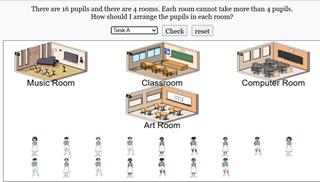Credits
['kangRui', 'meiYoke', 'looKang']
Credits
['kangrui', 'lookang', 'storyboard by meiyoke']
Sample Learning Goals
[text]
For Teachers
 link
link
https://sg.iwant2study.org/ospsg/index.php/1263
-
18 pupils and 5 rooms.
-
Each room can take 1 to 4 pupils.
-
Scenario B:
link
https://sg.iwant2study.org/ospsg/index.php/1263
-
16 pupils and 4 rooms.
-
Each room can take 1 to 4 pupils.
-
Features
1. Dynamic Problem Solving
The simulation calculates the optimal arrangement of pupils and animates their movement to the respective rooms. The logic behind the arrangement ensures that:
-
Each room’s constraints are respected.
-
Pupils are distributed fairly.
2. Animation with ODE (Ordinary Differential Equations)
The simulation uses the ODE engine to animate pupils smoothly. Each pupil moves from their starting position to their target room, making the process visually engaging.
3. Scenarios for Varying Difficulty
The simulation allows users to switch between predefined scenarios, each with its own constraints and challenges. This makes the activity suitable for different learning levels.
4. Real-Time Feedback
The simulation provides real-time feedback:
-
Pupils dynamically stop once they reach their target room.
-
The system pauses automatically once all pupils have been arranged.
Implementation Details
1. Core Logic
The pupil arrangement algorithm works as follows:
-
Calculate the number of pupils needed for each room based on the constraints.
-
Assign pupils to rooms while respecting the minimum and maximum limits.
-
Dynamically update the positions of pupils for animation.
2. Animation Using ODE
The pupils' motion is governed by equations in the EJS ODE editor. For each pupil:
 |
| link https://sg.iwant2study.org/ospsg/index.php/1263 |
-
The rate of movement is proportional to the distance between the current and target positions:
-
The motion stops when the distance is less than a defined threshold (e.g., 0.01).
link
https://sg.iwant2study.org/ospsg/index.php/1263
3. Stopping Condition
A fixed relationship ensures the simulation checks whether all pupils have reached their targets:
-
If the distance to the target for all pupils is below the threshold, the ODE solver pauses.
4. Scenario Switching
Each scenario is defined by:
-
The number of pupils.
-
The number of rooms.
-
Constraints for each room (minimum and maximum pupils).
User Interface
Simulation View
-
Room Layout
-
Each room is visually represented with a unique design.
-
Rooms are labeled for clarity (e.g., Music Room, Classroom).
-
-
Pupils
-
Pupils are represented by avatars, each with a unique number.
-
Pupils start at the bottom of the screen and move to their assigned rooms.
-
-
Controls
-
Dropdown menu to select a scenario.
-
Buttons for actions such as "Check" and "Need Help?"
-
Educational Benefits
1. Visualization of Constraints
The simulation allows students to visually understand constraints and how they affect distribution. This helps develop problem-solving and critical thinking skills.
2. Interactive Learning
The dynamic animation engages students and makes learning fun and interactive.
3. Application of Mathematics
The simulation incorporates mathematical concepts like optimization and equations of motion, making it a practical tool for teaching STEM topics.
Behind the Scenes: Development Insights
Challenges Addressed:
-
Animation Logic:
-
Smoothly animating the pupils while ensuring they stop precisely at their targets required careful use of the ODE engine.
-
-
Scenario Flexibility:
-
Designing the system to handle varying room and pupil constraints required modular and scalable logic.
-
Debugging Techniques:
-
Extensive use of
console.logto verify the positions of pupils during motion. -
Threshold checks to ensure accurate stopping conditions.
Future Enhancements
-
Custom Scenarios:
-
Allow users to create their own scenarios with customizable constraints.
-
-
Performance Optimization:
-
Optimize the ODE solver for larger scenarios with more pupils and rooms.
-
-
Gamification:
-
Add a scoring system to make the activity more engaging.
-
Conclusion
The Arrange Pupils in Rooms EJS simulation is an excellent example of how interactive tools can enhance learning. By combining optimization, animation, and real-time feedback, the simulation offers a rich educational experience for students. Whether you're a teacher looking to make lessons more engaging or a student exploring problem-solving, this simulation is sure to captivate and educate.
earlier version
 link link2
link link2
In the digital age, traditional teaching methods are being transformed by technology, offering more dynamic and engaging ways to learn. One such tool that has been making a significant impact in educational settings is Easy JavaScript Simulations (EJS). EJS allows educators to create interactive simulations that bring complex concepts to life through digital manipulation. In this blog, we'll explore an intriguing EJS simulation focused on arranging pupils in classrooms, highlighting how such tools can enhance learning experiences.
The Room Arrangement Challenge
The simulation presents a straightforward but engaging problem: there are 18 pupils, and they need to be arranged into 5 different rooms. Each room has a maximum capacity of 4 pupils, creating a scenario where students must carefully consider how to distribute the pupils without exceeding room limits. The rooms are labeled as the Music Room, Science Room, Computer Room, Art Room, and Math Room, and students are encouraged to explore various configurations to find the correct solution.
This activity goes beyond simple math; it introduces students to problem-solving techniques, logical thinking, and even aspects of planning and strategy. By trying different arrangements, they learn to work within constraints, a skill that is highly applicable in real-world scenarios.
Why Digital Manipulation Matters
One of the standout features of this EJS simulation is its ability to let students manipulate the digital environment directly. In a traditional classroom setting, a similar problem might be posed using pen and paper or verbal instructions. However, with digital manipulation, students can drag and drop elements (in this case, the pupils) into different rooms, testing their ideas in real-time. This interactive component makes the learning process more engaging and hands-on, leading to a deeper understanding of the concepts being taught.
When students can move objects around the screen, they gain a visual and tactile understanding of the problem. This form of interaction is especially effective for visual learners, as it allows them to see the immediate results of their actions, making abstract concepts more concrete. Additionally, this kind of hands-on learning can improve retention, as students are more likely to remember something they actively engaged with compared to information they passively absorbed.
Scenario-Based Learning and Immediate Feedback
Another powerful feature of this EJS simulation is the use of scenarios. By offering multiple scenarios (e.g., "Scenario A," "Scenario B"), the simulation introduces variation and complexity, challenging students to think beyond a single solution. This scenario-based approach mimics real-life situations, where problems rarely have one-size-fits-all solutions, encouraging flexibility and adaptability in students' thinking.
The "Check" button further enhances the learning experience by providing immediate feedback. Students can see right away whether their arrangement works, allowing them to reflect on their decisions and make adjustments as needed. This instant feedback loop fosters a trial-and-error approach, where students learn that making mistakes is part of the learning process. This ability to iterate on their solutions encourages perseverance and critical thinking, helping students develop a growth mindset.
Beyond the Classroom: Skills for the Future
Interactive simulations like this one are not just about teaching specific subject matter; they also equip students with essential skills for the future. In today's world, where digital literacy is as crucial as traditional literacy, students must be comfortable interacting with digital tools. This simulation helps them gain confidence in using digital interfaces, manipulating data, and understanding feedback loops, all of which are vital skills in many fields, from engineering to business.
Moreover, the problem-solving aspect of this simulation encourages students to think critically and creatively. In arranging the pupils, they must consider different strategies, evaluate their effectiveness, and be willing to rethink their approach if it doesn’t work. This mirrors the kind of strategic thinking required in fields like project management, programming, and even daily life scenarios, where effective planning within constraints is often needed.
Creating a Collaborative Learning Environment
One of the additional benefits of using EJS simulations is the opportunity to foster collaboration among students. In a classroom setting, teachers can encourage students to work in pairs or small groups to solve the room arrangement problem. This not only enhances engagement but also promotes teamwork and communication. Students learn to share their thoughts, listen to others' perspectives, and work together to reach a common goal. The simulation can serve as a starting point for deeper discussions about strategies, patterns, and the thought process behind different approaches.
The Role of Educators in Facilitating Digital Learning
While EJS simulations are a fantastic tool for self-guided learning, the role of educators remains crucial. Teachers can use these simulations to introduce new topics, reinforce key concepts, or even as a form of assessment. By guiding students through the simulation and asking thought-provoking questions, educators can help them connect the dots between the activity and the broader lessons they are learning.
Additionally, educators can modify simulations or create new ones tailored to their curriculum, ensuring that the digital tools they use align with their educational goals. The flexibility of EJS makes it an excellent choice for educators looking to integrate technology into their teaching in a meaningful way.
Conclusion: The Future of Learning with EJS
The room arrangement simulation is just one example of how EJS can transform traditional educational activities into engaging, interactive learning experiences. By allowing students to manipulate digital elements, receive immediate feedback, and explore different scenarios, this tool promotes a more active form of learning that can improve understanding, retention, and problem-solving skills.
As education continues to evolve in the digital age, tools like EJS will play a vital role in preparing students for the challenges of the future. By making learning more interactive and engaging, these simulations help students develop not just academic knowledge, but also the critical thinking, adaptability, and digital literacy they will need to succeed in a rapidly changing world.
We are always looking for ways to make learning even more engaging. What features would you like to see added to this simulation? Perhaps an autosolve() feature that shows one possible solution for students to study, or a hint system that provides step-by-step guidance? Maybe you'd like to see a scoring system that rewards efficient arrangements or a feature that allows students to create their own room challenges? Feel free to share your ideas and help us shape the future of interactive learning!
Research
[text]
Video
[text]
Version:
- https://weelookang.blogspot.com/2024/12/exploring-arrange-pupils-in-rooms-ejs.html
- https://weelookang.blogspot.com/2024/10/engaging-students-with-interactive.html
Other Resources
[text]
end faq
{accordionfaq faqid=accordion4 faqclass="lightnessfaq defaulticon headerbackground headerborder contentbackground contentborder round5"}
- Details
- Written by Loo Kang Wee
- Parent Category: Interactive Resources
- Category: Mathematics
- Hits: 2155











